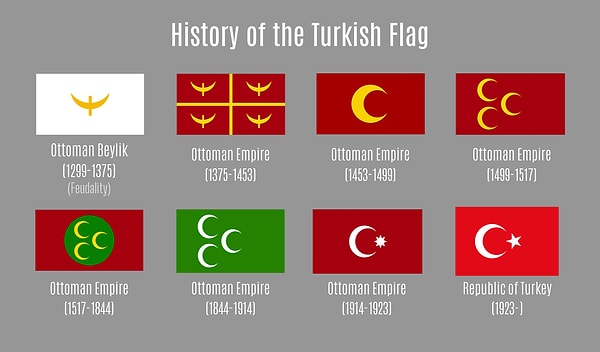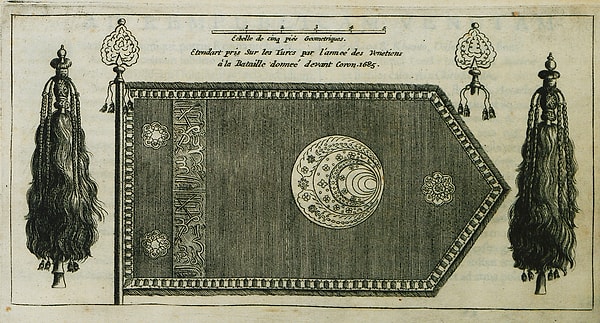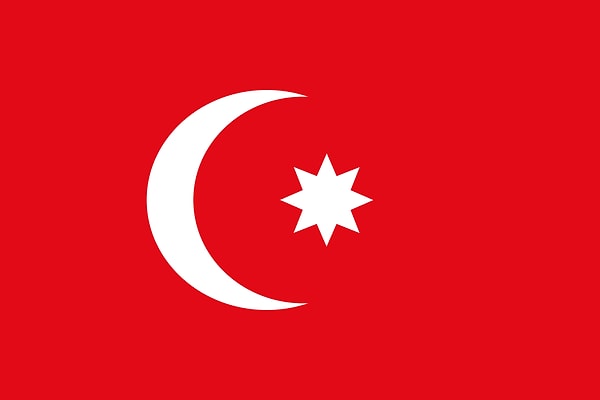The Ottoman Empire’s Flag: Origins, Uses, and Myths Explained
The Ottoman Empire had a state structure shaped not only politically and militarily, but also by symbols and rituals. The Ottoman flag is undoubtedly the most important of these symbols. The Ottoman flag was not just a piece of cloth, but a powerful symbol that reflected the spirit of an empire, its beliefs and its view of the world. In this article, we will present a detailed examination of the Ottoman flag, including its history, colours, symbols, areas of use and legends. Here is the History of the Ottoman Flag👇
From Primitive Banners to the Official Flag

In the early days of the Ottoman Empire, especially during its founding and rise to power, there was no ‘official flag’ in the modern sense. Instead, symbols such as “tuğ” and ‘sancak’ were preferred following the traditional Turkish understanding of statehood. These tuğs were portable symbols made from horse tails, representing the ruler's military authority. The number of tuğs indicated the sultan's rank; for example, three tuğs belonged to a beylerbey, while seven tuğs belonged to the sultan.
In the early periods, white-grounded sancaks, known as ‘Ak Sancak,’ were prominent. These sancaks were used more to represent the dynasty and the army. At that time, symbols such as the crescent or star were not yet included on the flag.
The Transformation Begins in the 18th Century
Over time, especially from the 18th century onwards, crescent and star symbols began to appear more frequently in Ottoman culture. During this period, Sultan Mustafa III and the sultans who followed him sought to make Islamic motifs more visible. The crescent had been adopted as the universal symbol of Islam, and the Ottoman flag also took its place in this world of meaning.
1793: Official Flag for the Ottoman Navy
In 1793, during the reign of Sultan Selim III, an official flag was designated for the Ottoman navy for the first time in history. This flag consisted of a white crescent and star on a red background. These symbols were also embraced by the people and quickly spread throughout the empire. The combined use of the crescent and star symbolised both religious (Islamic) and secular (state) authority.
1844: The Modern Flag with the Tanzimat Reforms
With the Tanzimat Period, Western-style state regulations gained momentum in the Ottoman Empire. In 1844, as part of the reforms enacted by Sultan Abdülmecid, the Ottoman flag became the official state symbol. According to this new regulation:
The flag would have a red background.
It would feature a white crescent and a five-pointed star.
This flag is the direct predecessor of the current flag of the Republic of Turkey.
1923 and After: Transition to the Republic of Turkey
When the Ottoman Empire officially came to an end in 1923, it was replaced by the Republic of Turkey. However, the flag remained unchanged. The modern form of the Ottoman flag was adopted and continued by the Republic of Turkey. In 1936, the first official law regarding the Turkish flag was enacted, standardising its dimensions and proportions.
Meaning of Colours and Symbols on the Ottoman Flag

Red Background
Red is a strong colour used by Turks since before Islam. In the Ottoman Empire, it was red;
The blood of martyrs,
Heroism,
It symbolised the military power of the state.
The red background was also chosen to ensure visibility in maritime contacts with Western countries, equivalent to ‘state banners’.
White Crescent
The crescent is the most well-known symbol of Islamic civilisation. The Ottomans emphasised their religious identity by using this symbol on their flag. The crescent also means:
The East and the newborn civilisation,
Divine protection,
It represents the continuity of power.
The inclusion of the crescent motif on the Ottoman flag was a political decision symbolising the Islamic leadership of the empire.
Five-pointed star
The star, combined with the crescent, provides an aesthetic and ideological unity. While the eight-pointed star was used in the early Ottoman period, the five-pointed star was preferred in the 19th century. The five-pointed star:
The five pillars of Islam,
Five prayers,
It has been interpreted to represent the five fundamental powers of the State.
Uses of the Ottoman Flag

In Land and Naval Forces
After 1793, the Ottoman navy started to use the red-white flag. In the land forces, especially army units and sultan's regiments carried flags. Each regiment could have special flags representing its own region.
Religious and Spiritual Use
Some Ottoman religious institutions also used flags with green backgrounds and crescents. Green represented the lineage of the prophet and religious authority. Especially in mosques, tombs and madrasahs, such flags were found.
Sancak-ı Şerîf
The Sancak-ı Şerîf, known as the most sacred Ottoman flag, is the flag rumoured to belong to the Prophet Muhammad. The Ottomans captured this flag during Yavuz Sultan Selim's Egyptian Campaign and preserved it in Topkapı Palace. This banner was carried when going to big battles. The Sultan would personally march in front of this flag.
Use of Palace and Protocol
In palaces, flags were used in certain ceremonies, enthronement and reception of ambassadors. In addition, the sultan's ‘has regiment' was represented by special tugh and banners. These flags were made of silk fabrics embroidered with gold and silver.
Legends about the Ottoman Flag

The Legend of the Battle of Kosovo (1389)
In many Ottoman narratives, it is said that the image of the moon and stars reflected in the pool of blood where an Ottoman soldier was martyred during the Battle of Kosovo was the inspiration for the symbols used in the flag. This legend is quite widespread among the people.
Osman Gazi's Dream
The legendary dream of Osman Gazi, the founder of the Ottoman Empire, is also associated with the flag. In his dream, he saw a crescent moon emerging from his chest and enveloping the whole world, which caused the crescent moon to become the symbol of the empire.
Inheritance Theory from Byzantium
Some historians claim that the crescent symbol was inherited from Byzantium after the conquest of Istanbul. As a matter of fact, the Byzantine Empire also used the crescent as a symbol of the city. The Ottomans may have tried to reinforce their legitimacy by adopting the symbols of the conquered lands.
Central Asian Turkish Culture Link
It is also argued that the origin of the crescent and star symbols dates back to the Central Asian Turks. Symbols on stones and coins from the Göktürk and Uyghur periods may indicate that the Ottoman flag emerged in cultural continuity.
The Ottoman flag is a strong state symbol consisting of a red background, white crescent and star.

It has developed and shaped over time and eventually transformed into the modern Turkish flag. With its colours, symbols, religious and political meanings, it bears the traces of not only a state but also a great civilisation. The legends told about the Ottoman flag show how this symbol was adopted and sanctified by the people.
The Ottoman flag is one of the rare symbols where history, culture, religion and politics are intertwined. Its traces continue to live on in the flag of the Republic of Turkey even today.
Keşfet ile ziyaret ettiğin tüm kategorileri tek akışta gör!

Send Comment